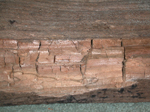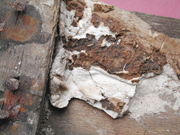Dry Rot:
Dry rot is the common name given to one particular wood destroying

fungus,
Serpula lacrymans. It is probably the most destructive of all wood rots, having the

ability to travel from one timber to another across damp masonry and soils.
Like all rots dry rot must have dampness to originate, develop and survive; it also likes stagnant conditions and it is therefore secretive and often difficult to find before significant damage has taken place.
Realcure's solution:
Our primary action is to identify the source of water ingress, stop it and promote rapid drying conditions.
Our next objective is to remove affected timbers and protect those that are unaffected but remain vulnerable. Replaced timbers are pre-treated and protected. Targeted chemical treatment will be used to assist in the control and prevention of further dry rot development. Where possible we will retain as much of the structure as possible to maintain the character of the property and minimise its costs.
Wet Rot:
Wet rot or rather wet 'rots' is the name given to all wood rots that are

not dry rot. In general terms wet rots are restricted to the wood and do not have the ability

to invade and spread across damp substrates like dry rot. Wet rots therefore tend to be very much more restricted in their distribution. A nevertheless like dry rot they require water to become initiated, grow and survive.
Realcure's solution:
As with dry rot our primary task is to find and eliminate the source of water causing the rot.
Severely rotted wood will be replaced with pre-treated timber, and other timbers will be isolated and protected from further dampness/rot in accordance with good building practice. As with dry rot we will, where possible, retain as much of the original structure as possible to maintain the character of the property and minimise costs. We may also use targeted chemical treatment to afford further protection of timbers.
 fungus, Serpula lacrymans. It is probably the most destructive of all wood rots, having the
fungus, Serpula lacrymans. It is probably the most destructive of all wood rots, having the  ability to travel from one timber to another across damp masonry and soils.
ability to travel from one timber to another across damp masonry and soils.  not dry rot. In general terms wet rots are restricted to the wood and do not have the ability
not dry rot. In general terms wet rots are restricted to the wood and do not have the ability  to invade and spread across damp substrates like dry rot. Wet rots therefore tend to be very much more restricted in their distribution. A nevertheless like dry rot they require water to become initiated, grow and survive.
to invade and spread across damp substrates like dry rot. Wet rots therefore tend to be very much more restricted in their distribution. A nevertheless like dry rot they require water to become initiated, grow and survive. 
